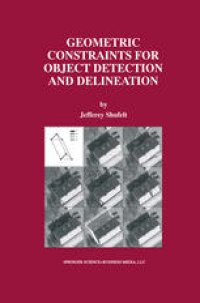
Ebook: Geometric Constraints for Object Detection and Delineation
Author: Jefferey Shufelt (auth.)
- Genre: Computers // Organization and Data Processing
- Tags: Remote Sensing/Photogrammetry, Computer Imaging Vision Pattern Recognition and Graphics, Computer Graphics, Artificial Intelligence (incl. Robotics), Data Structures Cryptology and Information Theory
- Series: The Springer International Series in Engineering and Computer Science 530
- Year: 2000
- Publisher: Springer US
- Edition: 1
- Language: English
- pdf
The ability to extract generic 3D objects from images is a crucial step towards automation of a variety of problems in cartographic database compilation, industrial inspection and assembly, and autonomous navigation. Many of these problem domains do not have strong constraints on object shape or scene content, presenting serious obstacles for the development of robust object detection and delineation techniques. Geometric Constraints for Object Detectionand Delineation addresses these problems with a suite of novel methods and techniques for detecting and delineating generic objects in images of complex scenes, and applies them to the specific task of building detection and delineation from monocular aerial imagery.
PIVOT, the fully automated system implementing these techniques, is quantitatively evaluated on 83 images covering 18 test scenes, and compared to three existing systems for building extraction. The results highlight the performance improvements possible with rigorous photogrammetric camera modeling, primitive-based object representations, and geometric constraints derived from their combination. PIVOT's performance illustrates the implications of a clearly articulated set of philosophical principles, taking a significant step towards automatic detection and delineation of 3D objects in real-world environments.
Geometric Constraints for Object Detection and Delineation is suitable as a textbook or as a secondary text for a graduate-level course, and as a reference for researchers and practitioners in industry.
The ability to extract generic 3D objects from images is a crucial step towards automation of a variety of problems in cartographic database compilation, industrial inspection and assembly, and autonomous navigation. Many of these problem domains do not have strong constraints on object shape or scene content, presenting serious obstacles for the development of robust object detection and delineation techniques. Geometric Constraints for Object Detectionand Delineation addresses these problems with a suite of novel methods and techniques for detecting and delineating generic objects in images of complex scenes, and applies them to the specific task of building detection and delineation from monocular aerial imagery.
PIVOT, the fully automated system implementing these techniques, is quantitatively evaluated on 83 images covering 18 test scenes, and compared to three existing systems for building extraction. The results highlight the performance improvements possible with rigorous photogrammetric camera modeling, primitive-based object representations, and geometric constraints derived from their combination. PIVOT's performance illustrates the implications of a clearly articulated set of philosophical principles, taking a significant step towards automatic detection and delineation of 3D objects in real-world environments.
Geometric Constraints for Object Detection and Delineation is suitable as a textbook or as a secondary text for a graduate-level course, and as a reference for researchers and practitioners in industry.